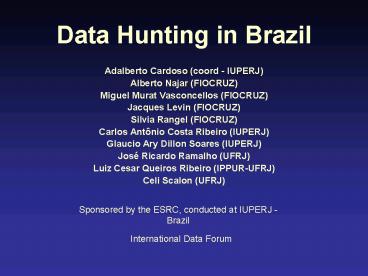Data Hunting in Brazil PowerPoint PPT Presentation
1 / 27
Title: Data Hunting in Brazil
1
Data Hunting in Brazil
- Adalberto Cardoso (coord - IUPERJ)
- Alberto Najar (FIOCRUZ)
- Miguel Murat Vasconcellos (FIOCRUZ)
- Jacques Levin (FIOCRUZ)
- Silvia Rangel (FIOCRUZ)
- Carlos Antônio Costa Ribeiro (IUPERJ)
- Glaucio Ary Dillon Soares (IUPERJ)
- José Ricardo Ramalho (UFRJ)
- Luiz Cesar Queiros Ribeiro (IPPUR-UFRJ)
- Celi Scalon (UFRJ)
Sponsored by the ESRC, conducted at IUPERJ -
Brazil
International Data Forum
2
(No Transcript)
3
(No Transcript)
4
(No Transcript)
5
(No Transcript)
6
(No Transcript)
7
(No Transcript)
8
(No Transcript)
9
(No Transcript)
10
(No Transcript)
11
(No Transcript)
12
Placed in the New World
- Brazil is as big as a Continent (more than 8
million square km and 8 thousand km of beaches) - 190 million people live there, 85 of which in
urban areas 36 of which in metropolitan areas - São Paulo Metr. Area alone hosts 10 of the
countrys population
13
Brazil is a federation of states
14
This makes it very hard to centralize data
production
- First, because many public policies are designed
at the local (state or municipality) level. So,
many states and cities and metropolises have
their statistics bureaus - Many administrative registers (specially on
violence ever, and health before 1988) are
gathered at the local level and centralized by a
federal agency - Concern for data validity and reliability is
increasing but there is still much to do
15
At the Federal Level, IBGE is the main data
producer and disseminator
- It is also responsible for the standardization of
socio-economic classifications (occupations,
economic sectors, product denominations and many
others)
- Celebrating 70 years
- It gathers data on population, economy (including
national and regional accounts), labour market
and many more
16
The main IBGE surveys are
- The Monthly Employment Household Survey (PME) in
6 metropolitan regions - Household budget surveys
- National Decennial Census Survey
- Annual National Household Sample Survey (PNAD),
80 thousand households and 400 thousand
individuals surveyed every year
17
- And Annual and Monthly Economic Surveys on
Manufacturing, Services, Commerce, Construction
and Agriculture - IBGE also hosts data produced by the ministries
of health and justice (violence data)
18
(No Transcript)
19
(No Transcript)
20
(No Transcript)
21
(No Transcript)
22
To access this information all you need is
- A good internet connection
If you want more sophisticated analysis
Then you can buy the CDs or access BME at a very
low price
23
IBGE has a stable staff of public servants
geographers, economists, statisticians,
sociologists, historians, biologists and many
others. But it does not produce in depth
socio-economic analysis
24
It relies on the academia for this matter.In
fact, the legitimacy of its methodologies and
procedures is built in close cooperation with
academic researchers.For instance, deep changes
in PNAD and PME are being discussed at this
precise moment with experts from more than 30
research institutions
25
The main problems
- All the material is in Portuguese
- Constant changes in methodology makes it
difficult (but not impossible) to compare surveys
over time - Standardization of old surveys is poor, one needs
to get through documentation very carefully, and
cooperation with local experts is inescapable
26
There are some important academic institutions
that host hundreds (sometimes thousands) of
surveys on all kinds of issues, from violence to
political values to demography and
consumption.The most important is CIS
(Consortium of Social Information), sponsored by
the ANPOCS(www.cis.org.br)
27
- The problem here is of a different sort
- We still have to create a culture of quantitative
social analysis. Most research programs in
leading universities are qualitative - So, it is difficult to convince the peers (who
are peer reviewers for funding agencies) that
money should be directed to expensive
quantitative research or archive, the results of
which they do not believe in

